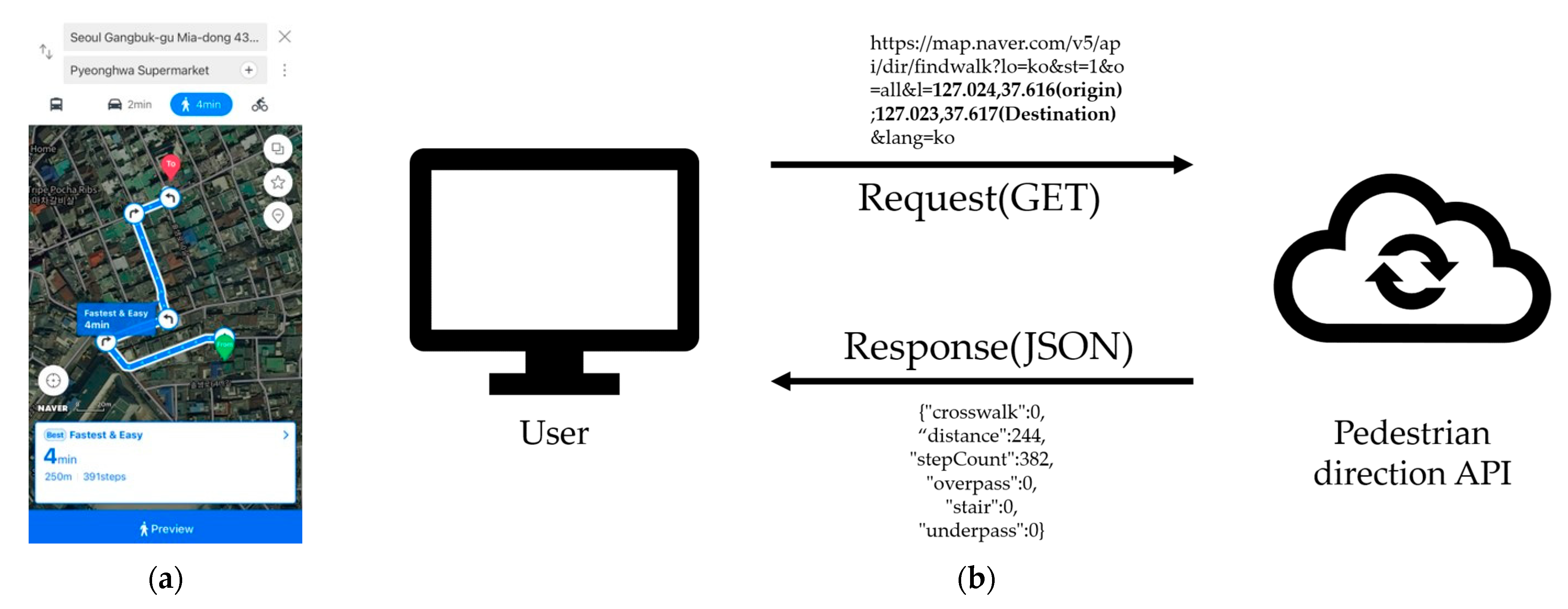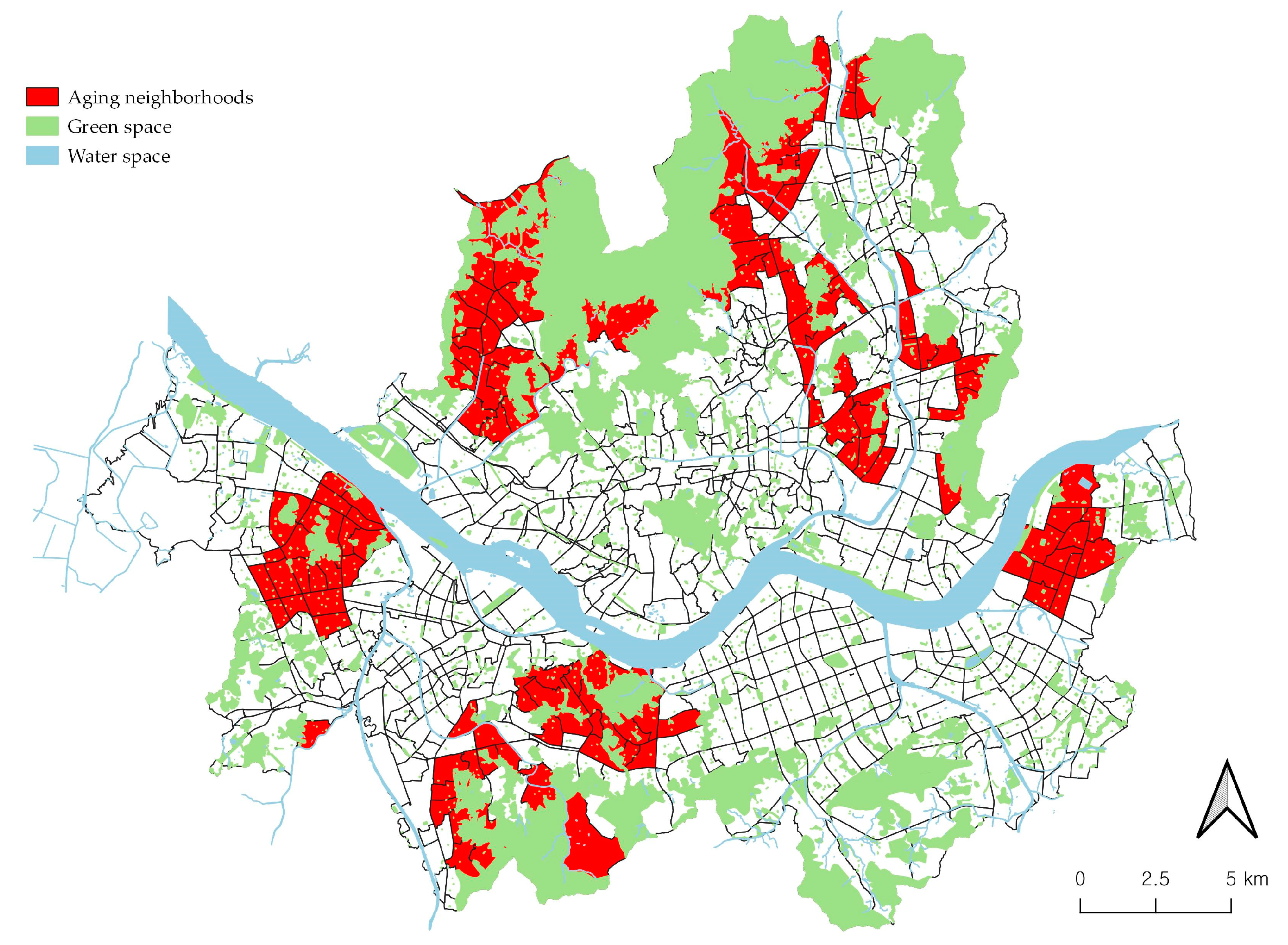Associations between Elderly Residents’ Supermarket Accessibility and Built Environmental Features in Seoul, Korea
Abstract
:1. Introduction
2. Materials and Methods
2.1. Study Area
2.2. Variables
2.3. Statistical Model
3. Results
4. Discussion
Author Contributions
Funding
Data Availability Statement
Conflicts of Interest
References
- Vojnovic, I. Urban sustainability: Research, politics, policy and practice. Cities 2014, 41, S30–S44. [Google Scholar] [CrossRef]
- Ewing, R.; Hamidi, S. Compactness versus sprawl: A review of recent evidence from the United States. J. Plan. Lit. 2015, 30, 413–432. [Google Scholar] [CrossRef]
- Frank, L.D.; Iroz-Elardo, N.; MacLeod, K.E.; Hong, A. Pathways from built environment to health: A conceptual framework linking behavior and exposure-based impacts. J. Transp. Health 2019, 12, 319–335. [Google Scholar] [CrossRef]
- Wali, B.; Frank, L.D.; Chapman, J.E.; Fox, E.H. Developing policy thresholds for objectively measured environmental features to support active travel. Transp. Res. Part D Transp. Environ. 2021, 90, 102678. [Google Scholar] [CrossRef]
- Lefebvre-Ropars, G.; Morency, C. Walkability: Which measure to choose, where to measure it, and how? Transp. Res. Rec. 2018, 2672, 139–150. [Google Scholar] [CrossRef]
- Cervero, R.; Kockelman, K. Travel demand and the 3Ds: Density, diversity, and design. Transp. Res. Part D Transp. Environ. 1997, 2, 199–219. [Google Scholar] [CrossRef]
- Ewing, R.H. Pedestrian-and Transit-Friendly Design: A Primer for Smart Growth; Smart Growth Network: Washington, DC, USA, 1999. [Google Scholar]
- Talen, E.; Shah, S. Neighborhood evaluation using GIS: An exploratory study. Environ. Behav. 2007, 39, 583–615. [Google Scholar] [CrossRef]
- Arellana, J.; Saltarín, M.; Larrañaga, A.M.; Alvarez, V.; Henao, C.A. Urban walkability considering pedestrians’ perceptions of the built environment: A 10-year review and a case study in a medium-sized city in Latin America. Transp. Rev. 2020, 40, 183–203. [Google Scholar] [CrossRef]
- Garfinkel-Castro, A.; Kim, K.; Hamidi, S.; Ewing, R. Obesity and the built environment at different urban scales: Examining the literature. Nutr. Rev. 2017, 75, 51–61. [Google Scholar] [CrossRef]
- Kim, S.; Park, S.; Lee, J.S. Meso-or micro-scale? Environmental factors influencing pedestrian satisfaction. Transp. Res. Part D Transp. Environ. 2014, 30, 10–20. [Google Scholar] [CrossRef]
- Hine, J.; Russell, J. Traffic barriers and pedestrian crossing behaviour. J. Transp. Geogr. 1993, 1, 230–239. [Google Scholar] [CrossRef]
- Anciaes, P.R.; Jones, P. Estimating preferences for different types of pedestrian crossing facilities. Transp. Res. Part F Traffic Psychol. Behav. 2018, 52, 222–237. [Google Scholar] [CrossRef]
- Coveney, J.; O’Dwyer, L.A. Effects of mobility and location on food access. Health Place 2009, 15, 45–55. [Google Scholar] [CrossRef] [PubMed]
- Schwartz, N.; Buliung, R.; Wilson, K. Disability and food access and insecurity: A scoping review of the literature. Health Place 2019, 57, 107–121. [Google Scholar] [CrossRef]
- Ewing, R.; Handy, S. Measuring the unmeasurable: Urban design qualities related to walkability. J. Urban Des. 2009, 14, 65–84. [Google Scholar] [CrossRef]
- Jeon, J.; Woo, A. Deep learning analysis of street panorama images to evaluate the streetscape walkability of neighborhoods for subsidized families in Seoul, Korea. Landsc. Urban Plan. 2023, 230, 104631. [Google Scholar] [CrossRef]
- Zhou, H.; He, S.; Cai, Y.; Wang, M.; Su, S. Social inequalities in neighborhood visual walkability: Using street view imagery and deep learning technologies to facilitate healthy city planning. Sustain. Cities Soc. 2019, 50, 101605. [Google Scholar] [CrossRef]
- Opach, T.; Navarra, C.; Rød, J.K.; Neset, T.-S. Pedestrian routing and perspectives: WayFinder’s route down the lane—Come on with the rain. ISPRS Int. J. Geo-Inf. 2021, 10, 365. [Google Scholar] [CrossRef]
- Ki, D.; Lee, S. Analyzing the effects of Green View Index of neighborhood streets on walking time using Google Street View and deep learning. Landsc. Urban Plan. 2021, 205, 103920. [Google Scholar] [CrossRef]
- Kim, D.; Park, J. Assessing Social and Spatial Equity of Neighborhood Retail and Service Access in Seoul, South Korea. Sustainability 2020, 12, 8537. [Google Scholar] [CrossRef]
- Consumer Behavior Survey for Foods for 2019. Available online: https://www.krei.re.kr/foodSurvey/selectBbsNttList.do?bbsNo=449&key=806 (accessed on 19 December 2022).
- Nathan, A.; Pereira, G.; Foster, S.; Hooper, P.; Saarloos, D.; Giles-Corti, B. Access to commercial destinations within the neighbourhood and walking among Australian older adults. Int. J. Behav. Nutr. Phys. Act. 2012, 9, 133. [Google Scholar] [CrossRef] [PubMed]
- Bae, S.-H.; Park, S.-H. Changes of Social Functions and Roles of Neighborhood Small Shops—A Case Study of Hae-bang-chon in Seoul-TT-Changes of Social Functions and Roles of Neighborhood Small Shops—A Case Study of Hae-bang-chon in Seoul. J. Urban Des. Inst. Korea Urban Des. 2015, 16, 21–36. [Google Scholar]
- La Rosa, D. Accessibility to greenspaces: GIS based indicators for sustainable planning in a dense urban context. Ecol. Indic. 2014, 42, 122–134. [Google Scholar] [CrossRef]
- Chen, Y.; Yue, W.; La Rosa, D. Which communities have better accessibility to green space? An investigation into environmental inequality using big data. Landsc. Urban Plan. 2020, 204, 103919. [Google Scholar] [CrossRef]
- Handy, S.L.; Niemeier, D.A. Measuring accessibility: An exploration of issues and alternatives. Environ. Plan. A 1997, 29, 1175–1194. [Google Scholar] [CrossRef]
- Jost, L. Entropy and diversity. Oikos 2006, 113, 363–375. [Google Scholar] [CrossRef]
- Jacobs, J. The Death and Life of Great American Cities; Random House: New York, NY, USA, 1961. [Google Scholar]
- Choi, S.; Won, J.; Kim, G.; Kim, S.; Park, C. Twenty Centuries of Seoul. 35, Urban Construction in Modern Seoul; Seoul Historiography Institute: Seoul, Republic of Korea, 2016. [Google Scholar]
- Ewing, R.; Cervero, R. Travel and the built environment: A meta-analysis. J. Am. Plan. Assoc. 2010, 76, 265–294. [Google Scholar] [CrossRef]
- Sung, H.-G.; Go, D.-H.; Choi, C.G. Evidence of Jacobs’s street life in the great Seoul city: Identifying the association of physical environment with walking activity on streets. Cities 2013, 35, 164–173. [Google Scholar] [CrossRef]
- Semantic Segmentation on MIT ADE20K Dataset in PyTorch. Available online: https://github.com/CSAILVision/semantic-segmentation-pytorch (accessed on 13 December 2022).
- Anselin, L. Spatial regression analysis in R: A workbook. Urbana 2005, 51, 61801. [Google Scholar]
- Anselin, L.; Bera, A.K. Spatial dependence in linear regression models with an introduction to spatial econometrics. Stat. Textb. Monogr. 1998, 155, 237–290. [Google Scholar]
- Sung, H.; Lee, S.; Cheon, S. Operationalizing jane jacobs’s urban design theory: Empirical verification from the great city of seoul, Korea. J. Plan. Educ. Res. 2015, 35, 117–130. [Google Scholar] [CrossRef]
- Lee, S.H.; Goo, S.H.; Chun, Y.W.; Park, Y.J. The spatial location analysis of disaster evacuation shelter for considering resistance of road slope and difference of walking speed by age-case study of Seoul, Korea. J. Korean Soc. Geospat. Inf. Sci. 2015, 23, 69–77. [Google Scholar]
- Dubey, A.; Naik, N.; Parikh, D.; Raskar, R.; Hidalgo, C.A. Deep learning the city: Quantifying urban perception at a global scale. In Proceedings of the European Conference on Computer Vision, Amsterdam, The Netherlands, 11–14 October 2016; Springer: Berlin/Heidelberg, Germany, 2016; pp. 196–212. [Google Scholar]
- Zhang, F.; Zhou, B.; Liu, L.; Liu, Y.; Fung, H.H.; Lin, H.; Ratti, C. Measuring human perceptions of a large-scale urban region using machine learning. Landsc. Urban Plan. 2018, 180, 148–160. [Google Scholar] [CrossRef]




| Variables | Measurements | Mean | S.D. | Min. | Max. | n |
|---|---|---|---|---|---|---|
| Dependent variable | ||||||
| Supermarket Accessibility | Mean accessibility of BUD group | 0.455 | 0.131 | 0.005 | 0.879 | 756 |
| Independent variables | ||||||
| Aging neighborhoods | Hot spot of the elderly by LISA analysis | 0.17 | 0.375 | 0.000 | 1.000 | 756 |
| Meso-scale | ||||||
| Density | ||||||
| Floor area ratio | Total floor area/BUD group area (km2) | 1.144 | 0.728 | 0.000 | 6.557 | 756 |
| Commercial building area | Commercial building floor area (km2) | 0.104 | 0.108 | 0.000 | 0.888 | 756 |
| Park area | Park area (km2) | 0.027 | 0.088 | 0.000 | 1.372 | 756 |
| Diversity | ||||||
| Building use diversity | Entropy index for building use diversity | 0.441 | 0.154 | 0.000 | 1.000 | 756 |
| Building age diversity | Entropy index for building age diversity | 0.525 | 0.243 | 0.000 | 1.000 | 756 |
| Design | ||||||
| Hilliness | Average slope of BUD group (°) | 2.806 | 2.792 | 0.067 | 14.318 | 756 |
| Intersection density | # of intersections/BUD group area (km2) | 59.808 | 50.496 | 0.000 | 366.584 | 756 |
| Four-way intersection ratio | # of 4-leg intersections/# of intersections | 0.266 | 0.208 | 0.000 | 1.000 | 756 |
| Micro-scale | ||||||
| Pedestrian crossing facility | Mean # of facilities per 100m | 0.239 | 0.159 | 0.000 | 1.404 | 756 |
| Sidewalk | Average # of object (sidewalk, wall, fence, tree) pixels per total pixels | 0.027 | 0.008 | 0.000 | 0.069 | 756 |
| Wall | 0.018 | 0.015 | 0.000 | 0.161 | 756 | |
| Fence | 0.013 | 0.007 | 0.000 | 0.063 | 756 | |
| Tree | 0.144 | 0.069 | 0.000 | 0.428 | 756 |
| Variables | OLS Model | Spatial Error Model | ||
|---|---|---|---|---|
| Coefficient | S.E. | Coefficient | S.E. | |
| Constant | 0.362 *** | 0.031 | 0.333 *** | 0.030 |
| Aging neighborhood | 0.044 *** | 0.012 | 0.036 ** | 0.014 |
| Floor area ratio | 0.017 ** | 0.007 | 0.019 *** | 0.007 |
| Commercial building area | 0.041 | 0.049 | 0.052 | 0.048 |
| Park area | −0.096 * | 0.051 | −0.062 | 0.048 |
| Land use diversity | 0.054 | 0.034 | 0.083 ** | 0.033 |
| Building age diversity | 0.070 *** | 0.023 | 0.064 *** | 0.022 |
| Hilliness | −0.003 * | 0.001 | −0.003 * | 0.002 |
| Intersection density | 0.000 | 0.000 | 0.000 | 0.000 |
| Four-way intersection ratio | −0.014 | 0.022 | −0.014 | 0.022 |
| Pedestrian crossing facility | −0.100 *** | 0.029 | −0.094 *** | 0.027 |
| Sidewalk | 2.179 *** | 0.592 | 2.645 *** | 0.577 |
| Wall | −0.298 | 0.324 | −0.162 | 0.310 |
| Fence | 0.395 | 0.660 | 0.279 | 0.644 |
| Tree | −0.138 * | 0.078 | −0.123 | 0.079 |
| Lambda | 0.377 *** | |||
| N | 756 | 756 | ||
| Moran’s I value | 0.157 *** | |||
| Lagrange multiplier (lag) | 46.342 *** | |||
| Lagrange multiplier (error) | 52.680 *** | |||
| Robust LM (lag) | 0.057 | |||
| Robust LM (error) | 6.395 ** | |||
| R-squared | 0.153 | 0.226 | ||
| Log likelihood | 525.863 | 549.788 | ||
| AIC | −1021.73 | −1065.540 | ||
| Schwarz criterion | −952.305 | −1000.750 | ||
Disclaimer/Publisher’s Note: The statements, opinions and data contained in all publications are solely those of the individual author(s) and contributor(s) and not of MDPI and/or the editor(s). MDPI and/or the editor(s) disclaim responsibility for any injury to people or property resulting from any ideas, methods, instructions or products referred to in the content. |
© 2023 by the authors. Licensee MDPI, Basel, Switzerland. This article is an open access article distributed under the terms and conditions of the Creative Commons Attribution (CC BY) license (https://creativecommons.org/licenses/by/4.0/).
Share and Cite
Kim, D.; Hwang, J.; Park, J. Associations between Elderly Residents’ Supermarket Accessibility and Built Environmental Features in Seoul, Korea. Buildings 2023, 13, 402. https://doi.org/10.3390/buildings13020402
Kim D, Hwang J, Park J. Associations between Elderly Residents’ Supermarket Accessibility and Built Environmental Features in Seoul, Korea. Buildings. 2023; 13(2):402. https://doi.org/10.3390/buildings13020402
Chicago/Turabian StyleKim, Donghyun, Jaeseok Hwang, and Jina Park. 2023. "Associations between Elderly Residents’ Supermarket Accessibility and Built Environmental Features in Seoul, Korea" Buildings 13, no. 2: 402. https://doi.org/10.3390/buildings13020402
APA StyleKim, D., Hwang, J., & Park, J. (2023). Associations between Elderly Residents’ Supermarket Accessibility and Built Environmental Features in Seoul, Korea. Buildings, 13(2), 402. https://doi.org/10.3390/buildings13020402





